වාහන වල Brake Fade වීම යනු කුමක්ද?
ඉංජිනේරු අංජන හේවාවසම් විසිනිඇතැම් අවස්ථා වලදී මෝටර් රථ අනතුරු වලට හේතු වන ප්රධානම කරුණක් ලෙස වාහන වල තිරිංග පද්ධති වල සිදුවන අසමත් වීම් සැලකිය හැකියි. ශ්රී ලංකාවේ සිදුවන, මෝටර් රථ සම්බන්ධ අනතුරු සැලකීමේදී, විශේෂයෙන්ම බර වාහන සහ කඳුකර ප්රදේශ වල ගමන් කරන වාහන වලට අදාල අනතුරු වලට හේතුව ලෙස ඒවායේ තිරිංග පද්ධති අකර්මණ්ය වීම බොහෝ විට සඳහන් වෙනවා. මෙහිදී වැදගත් කරුණක් වන්නේ සාමාන්යයෙන් පරීක්ෂා කිරීමකදී හොඳ තත්ත්වයේ ඇති බවට පෙනී යන තිරිංග පද්ධති පවා යම් යම් විශේෂ අවස්ථා වලදී නියමිත පරිදි ක්රියාත්මක නොවීම නිසා මෙවැනි අනතුරු සිදුවන බවයි. වාහනයක තිරිංග පද්ධතියක අවස්ථානුකූලව සිදුවිය හැකි මෙවැනි අසමත් වීම Brake Fade වීම ලෙස හඳුන්වන අතර මෙම ලිපියෙන් ඒ ගැන සරල පැහැදිලි කිරීමක් ඉදිරිපත් කෙරෙනවා.
චලනය වෙමින් පවතින පද්ධතියක අඩංගු වන චාලක ශක්තිය එයින් ඉවත් කිරීම මගින් පද්ධතිය නිශ්චලතාවයට පත්කිරීමට යොදාගන්නා යාන්ත්රික උපාංගයකට තිරිංගයක් (Brake) යයි කියනු ලබනවා. ඒ අනුව ගමන් කරමින් තිබෙන මෝටර් රථයක තිරිංග පද්ධතිය මගින් එහි අඩංගු චාලක ශක්තිය ඉවත් කිරීමෙන් එය නතර කරගැනීම සිදුවෙනවා. මෙහිදී ශක්ති සංස්ථිති මූලධර්මය අනුව, ගමන් කරමින් තිබෙන වාහනයේ චාලක ශක්තිය වෙනත් ශක්ති ප්රභේදයකට පරිවර්තයන කෙරෙනවා. භාවිත වන ආකාරය අනුව වාහන වල බහුලවම සහ ප්රධාන වශයෙන්ම යොදාගන්නා තිරිංග වර්ගය(Type of brake) වන්නේ Frictional brakes ය. Brake fade වීම පැහැදිලි කිරීමට අප ඉදිරියේදී සලකා බලන්නේ මෙම frictional brake පද්ධතියක ක්රියාකාරිත්වයයි.
මීට අමතරව පහත දැක්වෙන brake types ද යොදාගැනෙනවා.
Pumping brakes: - උදාහරණ ලෙස engine braking ක්රමවේදය සැලකිය හැකියි.
Electromagnetic brakes: - උදාහරණ ලෙස හයිබ්රිඩ් ඉලෙක්ට්රික් වාහන සහ ඉලෙක්ට්රික් වහන වල භාවිත වන Regenerative braking ක්රමවේදය සැලකිය හැකියි.
Friction brake වලදී වාහනයේ රෝද වලට සම්බන්ධවී චලනය වන කොටසක් (brake drum/brake disc) සහ ස්ථාවරව පවතින කොටසක් (brake shoe/brake pad) අතර ඇතිවන ඝර්ෂණය (friction) නිසා වාහනයේ චාලක ශක්තිය ඉවත් වීමෙන් එය නතර වීම සිදුවන අතර මෙහිදී ඉවත් වන චාලක ශක්තිය, තාප ශක්තිය බවට පරිවර්තනය කෙරෙනවා. ඒ අනුව සාමාන්යයෙන් වාහන වල භාවිත වන disc brakes හෝ drum brakes හෝ වලින් සමන්විත වන ප්රධාන තිරිංග පද්ධති (service brake) සහ පාකින් තිරිංග පද්ධති (parking/emergency/hand brake) වල ක්රියාකාරිත්වය වන්නේ මෙයයි.
මෙවැනි තිරිංග පද්ධතියක තිබිය යුතු වැදගත්ම ගුණාංගයක් වන්නේ තිරිංග යෙදීමේදී ඇතිවන විශාල තාප ප්රමාණය ඉක්මණින් එයින් ඉවත් කර එහි උෂ්ණත්වය ප්රශස්ත මට්ටමක පවත්වාගත හැකි වීමයි. තිරිංග පද්ධතියේ කොටස් සැලසුම් කිරීමේදී යොදාගන්නා ද්රව්ය සහ සිසිලන ක්රමවේදයන් මගින් මෙම අවශ්යතාවය සපුරාලනු ලබනවා. ඒ අනුව තිරිංග යෙදීමේදී ඉහළ උෂ්ණත්වයකට රත් වන පද්ධතියේ කොටස් වල ඇති තාපය, සන්නයනය(conduction), සංවහනය(convection) සහ විකිරණය(radiation) යන ආකාර වලින් ඉවත්වීම (dissipation of heat) සිදුවෙනවා. තිරිංග පද්ධතියේ නිසි ක්රියාකාරිත්වය සඳහා එහි තාපය නිපදවෙන ශීග්රතාවයට වඩා වැඩි ශීග්රතාවයකින් තාපය ඉවත් වීම සිදුවිය යුතු වන අතර ඇතැම් අවස්ථා වලදී පද්ධතියෙන් තාපය ඉවත් විය හැකි ශීග්රතාවයට වඩා වැඩි ශීග්රතාවයකින් ඒ තුල තාපය එක් රැස් වීම නිසා (thermal saturation) ඇතිවන අධික උෂ්ණත්වය හේතුවෙන් තිරිංග පද්ධතියේ කොටස් වල වෙනස්කම් සිදුවී තිරිංග යෙදීමේ සිදුවන ක්ෂණික අසමත් වීම brake fade වීම ලෙස හැඳින්වෙනවා.
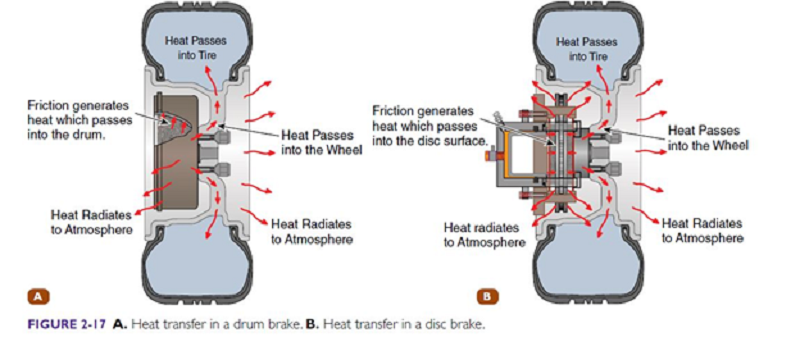
කලින් සඳහන් කළ පරිදි තිරිංග පද්ධතියේ වෙනත් කිසිම දෝෂයක් (උදාහරණ ලෙස; කොටස් වල ගෙවීම, නිවැරදිව සීරුමාරු නොවීම, තිරිංග ෆ්ලුයිඩ් වල ගැටලු, සම්පීඩිත වාතය සම්බන්ධ ගැටලු වැනි කරුණු ) නොමැතිව හොඳින් ක්රියාත්මක වෙමින් තිබුණත්, අවස්ථානුකූලව මෙම brake fade වීම ඇතිවිය හැකිවීම මෙහි විශේෂත්වය වනවා.
එනම් ඉතා අධික වේගයකින් ගමන් කරමින් සිට තදින් තිරිංග යෙදීම, අධික බරක් පටවාගෙන යන වාහනයක් තදින් තිරිංග යෙදීම, පල්ලමක ගමන් කිරීමේදී දිගින් දිගටම තදින් තිරිංග යොදාගෙන යාම, වඩා ඉක්මන් කාලාන්තර වලදී වරින් වර තිරිංග යෙදීම වැනි අවස්ථා වලදී තිරිංග පද්ධතිය සිසිල් වීමට කලින් ඉතා අධික තාප ප්රමාණයක් ඒ තුල එක් රැස් වී ඉහළ උෂ්ණත්වයකට රත් වීම නිසා මෙම brake fade වීම සිදුවෙනවා. තිරිංග පද්ධතියේ සමහර දෝෂ වලදී මෙන් තිරිංග බලයේ ක්රමික අඩුවීමක් ඇතිවීම වෙනුවට brake fade වීමකදී එක වරම තිරිංග බලය නැතිවී යාම සිදුවිය හැකිවීම මෙහි ඇති අවධානම වනවා. ඒ අනුව එවැනි අවස්ථාවක රියදුරාට තිරිංග මගින් වාහනය පාලනය කිරීමේ හැකියාව අහිමි වන අතර බොහෝ විට එය අනතුරකට හේතු වනවා. එසේම ඇතිවූ අධික උෂ්ණත්වය අඩුවී ගිය පසු තිරිංග පද්ධතිය සාමාන්ය තත්ත්වයට පත්වීම මෙහි ඇති තවත් විශේෂත්වයක් වනවා. Brake fade වීම එකිනෙකට වෙනස් ආකාර කිහිපයකින්ම සිදුවිය හැකි වන අතර එය පහත පරිදි පැහැදිලි කළ හැකියි.
Friction fade/lining fade/pad fade
ඉහත සඳහන් කළ පරිදි තිරිංග පද්ධතියක් චාලක ශක්තිය තාප ශක්තිය බවට හරවා ඉවත් කරන්නේ එකිනෙක ගැටෙන පෘෂ්ඨ අතර ඝර්ෂණය නිසයි. උෂණත්වය අනුව මෙම පෘෂ්ඨ අතර ඝර්ෂණය වෙනස් වන ආකාරය පහත වක්රයෙන් දැක්වෙනවා. ඒ අනුව එක්තරා සීමාවක් දක්වා උෂ්ණත්වය ඉහල යාමේදී ඝර්ෂණය වැඩි වී ඉන් පසු එක වරම එය අඩු වන බව පෙනී යනු ඇත.
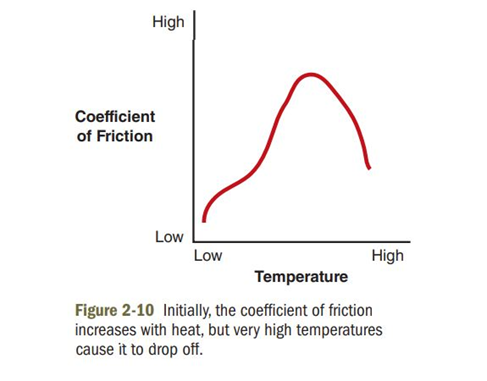
ඉතා ඉහල උෂ්ණත්වයකට රත්වීමේදී තිරිංග පද්ධතියේ ඝර්ෂණය බිඳ වැටීම නිසා තවදුරටත් තිරිංග බලය ලබාදිය නොහැකි වනවා. මේ අවස්ථාවේදී hydraulic brake පද්ධතියක නම් පෙඩලය සාමාන්ය ලෙස දැනීම හෝ තරමක් තද වැඩි ගතියකින් දැනීම හෝ සිදුවිය හැකි අතර air brake පද්ධතියක නම් පෙඩලය තරමක් ලිහිල් ලෙස දැනිය හැකිය. මෙවැනි අවස්ථාවකදී තිරිංග පැඩලය තවදුරටත් තදින් පෑගීමේදී brake fade වීම තවදුරටත් වැඩිපුර සිදුවනවා.
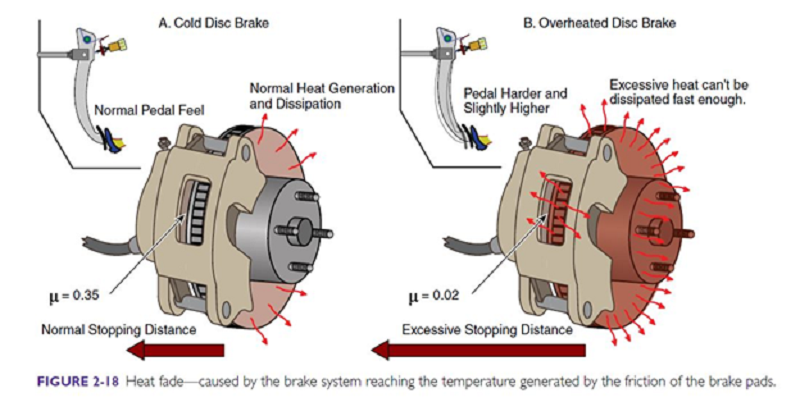
මෙවැනි අවස්ථා වලදී ඉහළ උෂ්ණත්වයන්ට රත් වීම නිසා brake pads/brake liners/shoes වල අඩංගු සමහර සංයෝග කොටස් සහ brake rotor discs/drums සාදා ඇති ලෝහ කොටස් තාප විපර්යාසයන්ට ලක් වී ඝර්ෂණ පෘෂ්ට අතර ස්ථර ඇතිවීමෙන් ඝර්ෂණය තවදුරටත් අඩුවී තිරිංග බලය තවදුරටත් අඩු වෙනවා. බේක් පද්ධතියේ කොටස් සැලසුම් කිරීමේදී සහ එම කොටස් නිපදවීම සඳහා ද්රව්ය තෝරාගැනීමේදී මෙම friction fade වීම අවම කිරීමට අවශ්ය ක්රියමාර්ග අනුගමනය කෙරෙනවා. සාමාන්යයෙන් Disc brake පද්ධතියකට friction fade එකෙන් වන බලපෑම අඩු වන අතර (brake disc එක හරහා සිදුවන වඩා හොඳ සිසිලන ක්රියාව නිසා) එයින් වැඩිම බලපෑමක් වන්නේ drum brake පද්ධති වලටයි.
Mechanical fade
මෙය සිදුවන්නේ drum brake පද්ධති වලයි. ඉහළ උෂ්ණත්වයන්ට රත් වීමේදී brake drum එක පිටතට ප්රසාරණය වීම නිසා ඒ මත brake shoes/liners මගින් ඇති කරන ඝර්ෂණය අඩු වී තිරිංග බලය අඩු වනවා. මෙහිදී බොහෝ විට තිරිංග පෙඩලය වඩා පහලට ගමන් කිරීමක් දැනිය හැකි වනවා. මෙහි අවසන් අදියරේදී තිරිංග පෙඩලය යටටම පෑගුවද ප්රමාණවත් නොවන තරමට brake drum එක ප්රසාරණය වී විශාල වීමෙන් තිරිංග බලය සම්පූර්ණයෙන්ම නැතිවී යාම සිදු වනවා. Disc brake පද්ධතියකදී brake rotor disc එකේ සිදුවන ප්රසාරණයේ දිශානතිය අනුව මෙම mechanical fade එකේ බලපෑමක් එයට ඇතිවන්නේ නැහැ.
Fluid fade/hydraulic fade
මෙය අදාල වන්නේ hydraulic brake පද්ධති වලටයි. මෙම පද්ධති වල යොදාගන්නා hydraulic brake fluid එක සාමාන්ය තත්ත්ව වලදී අසම්පීඩ්ය තරලයක් (incompressible fluid) ලෙසයි සැලකෙන්නේ. නමුත් ඉතා ඉහළ උෂ්ණත්ව වලට රත් වීමේදී මෙම brake fluid එක එහි තාපාංකයට එලඹී වාෂ්ප ඇතිවීමේ හැකියාවක් තිබෙනවා. මෙසේ ඇතිවන වාෂ්ප සම්පීඩනය කළ හැකි නිසා තිරිංග යෙදීමේදී පෙඩලය ලිහිල් ස්වභාවයකට පත්වී පහළටම ගමන් කිරීම සිදුවන අතර තිරිංග බලය නියමිත පරිදි නොලැබී යනවා. Brake fluid එක හා ජල වාෂ්ප මිශ්ර වී තිබුණහොත් මෙම තත්ත්වය තවත් නරක අතර හැරෙනවා.
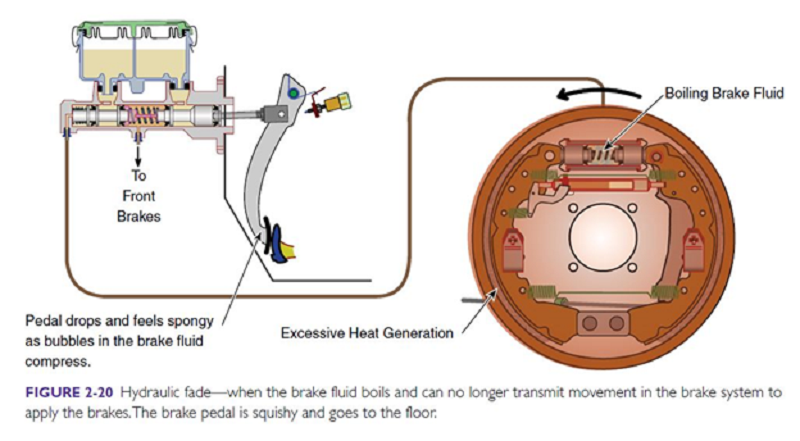
Domino fade
තිරිංග පද්ධතියෙන් රෝද වලට යෙදෙන තිරිංග බලය සමාකාරව ව්යාප්ත නොවී, එක රෝදයක හෝ කිහිපයක හෝ තිරිංග බලය අසාමාන්ය ලෙස වැඩි වී එම රෝදයට අදාල තිරිංග පද්ධතියේ කොටස අධික උෂ්ණත්වයකට රත් වීමෙන් එම ස්ථානයේ friction fade එකක් සිදුවීම සහ එහිදී ඇතිවන තාපය නිසා fluid fade එකක් ඇති වී තිරිංග පද්ධතියේ ක්රියාකාරිත්වය අඩපණ වීම මෙහිදී සිදුවනවා. එසේම එක රෝදයක තිරිංග බලය වැඩි වී එයට යෙදෙන තිරිංග බලය මුලින් අක්රිය වීමෙන් ඉතිරි රෝද වලට යෙදෙන තිරිංග බලය අසමාන ලෙස ව්යාප්ත වීමෙන් එම රෝද වලත් brake fade වීමේ හැකියාවක් තිබෙනවා.
Gas fade
ඉතා දිගු වේලාවක් ඉතා තදින් තිරිංග යෝදාගෙන යාමේදී brake pads/liners සෑදීමට යොදාගන්නා ද්රව්ය වල ඇතිවන තාප විපර්යාස නිසා හටගන්නා වායු වර්ග, ඉතා තුනී ස්ථරයක් ලෙස එම ඝර්ෂණ පෘෂ්ඨ අතර පැවතීමෙන් ඝර්ෂණය අඩුවී තිරිංග බලය අඩු වීම මෙහිදී සිදු වෙනවා
Green/early life pad fade
මෙය සිදුවන්නේ අලුතින්ම brake pads/shoes යොදා ඇති අවස්ථා වලදීය. අලුත් brake pads/shoes මුල් වරට භාවිතයේදී ඉතා තද බේක් පහරවල් නිසා ඉහළ උෂ්ණත්වයන්ට රත් වීමේදී ඉහත විස්තර කළ pad fade, gas fade ක්රියාවලීන් ඇතිවීමේ හැකියාව තිබෙනවා. කෙසේ නමුත් අලුතින් brake pads/shoes යෙදූ පසු එය brake discs/drums සමග හොඳින් සම්බන්ධ වීමට සැලැස්වීමේ ක්රියාවලිය (bedding process) මගින් මෙය පහසුවෙන්ම වළක්වාගත හැකිය. Bedding period එකෙන් පසුවත්, යොදාගෙන ඇති brake pads/liners - discs/drums කොටස් අතර නොගැලපීම් නිසා තිරිංග බලය අඩුවී යාම dynamic fade ලෙස හැඳින්වෙනවා.
Water fade
ඉහත සඳහන් කළ ක්රියාවලින්ට තරමක් වෙනස් වන මෙහිදී සිදුවන්නේ තිරිංග පද්ධතියේ ඝර්ෂණ පෘෂ්ඨ අතරට ජලය එක් රැස් වීමෙන් එහි ඝර්ෂණය අඩු වී තිරිංග බලය අඩුවීමයි. වැසි දිනවල/රෝද මට්ටමට වඩා උඩින් ජලය ඇති මාර්ග වල ධාවනයේදී මෙම තත්ත්වය ඇතිවිය හැකිය.
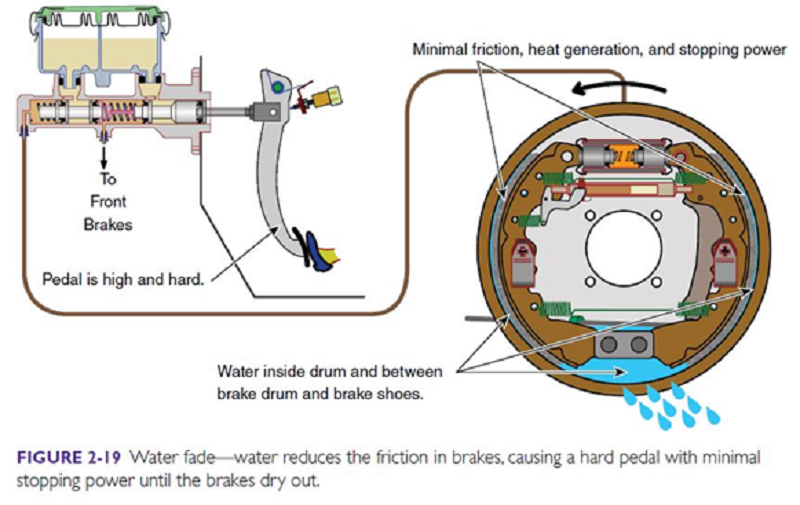
සාමාන්යයෙන් පලපුරුදු රියදුරෙකුට පහසුවෙන් මෙම brake fade වීමේ තත්ත්වයන් හඳුනාගත හැකිය. ඒ අනුව තිරිංග පෙඩලයේ අසාමාන්ය තත්ත්වයක් දැනීම, තිරිංග ප්රතිචාර වල අසාමාන්ය තත්ත්වයන් තිබීම සහ අධික උෂ්ණත්වය නිසා තිරිංග පද්ධතියේ කොටස් වලින් ඇතිවන ගන්ධයන් මගින් brake fade වීමක් ඇති බව හඳුනාගෙන හැකි ඉක්මණින් ආරක්ෂිත ලෙස වාහනය නවතා ගැනීමට කටයුතු කිරීම වැදගත් වනවා.
වාහනයක තිරිංග පද්ධති සැලසුම් කිරීමේදී සහ කොටස් නිෂ්පාදනයේදී, ඉහත සඳහ කළ පරිදි විවිධ ආකාර වලින් සිදුවිය හැකි brake fade වීම් වලක්වා ගැනීමට හෝ අවම කරගැනීමට හෝ හැකි වන පරිදි නිෂ්පාදකයන් එම කටයුතු සිදු කරනවා. සාමාන්යයෙන් වාහන භාවිතයේදී brake fade විම් වලක්වා ගනිමින් අනතුරු වලක්වාගැනීමට පහත පියවර අනුගමනය කළ හැකියි.
- අනවශ්ය පරිදි තදින් තිරිංග යෙදීමේ අවස්ථා හැකිතරම් අවම කරගැනීම.
- ධාවන තත්ත්වය අනුව වේගය තීරණය කරමින් තිරිංග යෙදීමේ වාර ගණන අඩු කරගැනීම.
- වාහනයට නිර්දේශිත ප්රමාණයට වඩා වැඩියෙන් බර පටවාගෙන යාමෙන් වැලකීම.
- පල්ලම් වල ගමන් කිරීමේදී දිගින් දිගටම තිරිංග යොදාගෙන යාමෙන් වැලකී, ඉක්මණින් අඩු ගියරයකට මාරු කර engine braking යොදාගැනීම.
- නොවැලැක්විය හැකි තත්ත්වයකදී දිගින් දිගටම තිරිංග යෙදීමට සිදු වේ නම්, එක දිගටම එසේ ගමන් නොකර වාහනය විටින් විට නවත්වා තබමින් ගමන් කිරීම.
- නිෂ්පාදිතයා නිර්දේශ කර ඇති brake fluid වර්ගය නියමිත ලෙස යෙදීම සහ එය නිසි කලට මාරු කිරීම.
- අලුතින් brake pads/shoes යෙදූ විට නිසි පරිදි bedding process එක අනුගමනය කිරීම.
Sources:-
Automotive Braking Systems by Nicholas Goodnight & Kirk VanGelder
Automotive Brake Systems – Classroom Manual by Ken Pickerill
What is brake fade and how to prevent it?
By Eng. Anjana HewawasamIn certain instances, failures in the brake systems can be considered a major cause of motor vehicle accidents. In Sri Lanka, brake failures are mostly cited as the cause of accidents involving heavy vehicles with high loads and vehicles travelling down long, steep hills. It is important to note that even brake systems that normally appear to be in good operational condition could be susceptible to failures at times. This type of occasional failure of a vehicle's brake system is called Brake Fade. This article provides a simple explanation of this.
A mechanical device used to inhibit the motion of a moving system by absorbing its kinetic energy is called a brake. Accordingly, the brake system of a moving vehicle removes its kinetic energy making it stop. According to the principle of the conservation of energy, the kinetic energy absorbed from the moving vehicle is converted into another type of energy by the brake system. In terms of application, the most common and mainly used types of brakes in motor vehicles are frictional brakes. We will further consider the function of frictional brakes to explain brake fade in this article.
Apart from the frictional brakes, the following types of brakes are also used in vehicles.
Pumping brakes – Ex: - engine braking
Electromagnetic brakes – Ex: - regenerative braking used in electric and hybrid electric vehicles
In frictional brakes, the friction between the surfaces of the rotating parts (brake discs/drums) and the stationary parts (brake pads/shoes) stops the vehicle by eliminating its kinetic energy. This kinetic energy absorbed by the brake system is then converted mainly into thermal energy and dissipated as heat. This is the working principle of the service and parking brake (emergency brake/hand brake) systems of vehicles consisting of disc brakes or drum brakes.
One of the most crucial requirements of frictional brake systems is that they should dissipate the excess amounts of heat generated and maintain their temperature at the optimum level for braking. This requirement is mainly fulfilled by the specific materials selected for the brake system parts and the cooling techniques used for the brake system components. Accordingly, the heat generated during braking is dissipated via conduction, convection and radiation from the brake system components which are subjected to high temperatures. For proper operation of the brake system, heat dissipation must occur faster than heat generation, and in some cases, parts of the brake system may overheat due to thermal saturation. The buildup of heat in the braking surfaces and the subsequent changes and reactions in the brake system components, causing an instant reduction in braking force, is called the brake fade.

As mentioned earlier, a brake system operating properly without any fault present (Ex:- Worn out brake pads/shoes, oil-contaminated brakes, misadjusted brakes, misaligned brake linings, sticking brake callipers etc.) could even cause a brake fade under certain critical operating conditions.
Brake fade could be occurred as a result of the extreme temperatures of the brake system due to the thermal saturation (generation of heat at a rate faster than cooling) caused by the conditions as follows.
- Braking hard at high speeds
- Braking too frequently in short timespans
- Continuous braking while travelling downhill
- Braking for too long, too often
- Driving aggressively
- Applying brakes in an overloaded condition, and so on
In contrast to the gradual loss of brake force in most of the other typical brake components failures, brake fade results in an instant reduction or loss of braking power, making it catastrophic most of the time. Such situations make the drivers losing the braking control of the vehicle and possibly lead to accidents. Another fact is that the system with brake fade can mostly come back to its normal operating condition once it is cooled down. Brake fade can occur in several different ways and can be explained as follows.
Friction fade/lining fade/pad fade
As mentioned above, a brake system converts kinetic energy into thermal energy due to the friction between the mating surfaces. The following curve shows how friction between these surfaces varies with temperature. Accordingly, until a particular limit, the friction increases with temperature and, then it drops off.

Upon reaching excessively high temperatures, the friction of the brake system decreases, resulting in loss of braking force. In this case, the brake pedal may feel normal, or slightly stiff in a hydraulic brake system and slightly soft in an air brake system. In this situation, further pressing the brake pedal worsens the brake fade.

Due to the extreme temperature, certain compounds contained in the friction surface materials of the brake pads/shoes start thermal degradation and also the metal surfaces of the brake rotor discs/liners start changing their phases with temperature. The result is the formation of a lubricating layer between the mating friction surfaces which eventually eliminate the braking power. In general, disc brake systems are comparably less prone to friction fade due to the better cooling action of the brake rotor discs, but drum brake systems are the most vulnerable.
Mechanical fade
It is commonly associated with drum brakes, but not disc brakes. In a drum brake, the brake shoe is applied outward toward the friction surface of the rotating drum. As the drum heats up, it expands outwards, increasing its diameter, moving it away from the lining application. The expansion of the brake drum creates a requirement for increased lining travel, and it causes the brake pedal travel to increase. If mechanical fade continues and the expansion of the brake drum becomes great enough, it could cause the pedal to bottom out and the brakes to fail.
The lining application of a disc brake is at a right angle to the rotating disc. The expansion of the disc is outward toward the application of the lining (pads) rather than away from it. Therefore it is considered that disc brakes have better resistance for the mechanical fade.
Fluid fade/hydraulic fade
It applies to hydraulic brake systems. The hydraulic brake fluid used in these systems is generally considered to be an incompressible fluid. But when heated to very high temperatures, this brake fluid can reach its boiling point and start vaporization. The vaporized fluid makes it compressible, increasing the brake pedal travel, making it feel spongy and the force transmitted to the lining reduced. If the brake fluid is contaminated with water due to moisture absorption, the situation becomes worse.

Domino fade
The brake force applied to the wheels by the brake system may not properly be distributed in some cases due to the reasons such as poor maintenance or improper load distribution etc. Then the brakes producing more braking force would heat up much quicker than others, causing friction-fade at that point. And also, this excessive heat could start vaporization of brake fluid and result in the fluid fade. In case of the failure of one brake, improper brake force distribution could result in brake fade on the other wheels as well.
Gas fade
When the brakes are applied too hard for a long period, the gases generated by the thermal degradation of the friction materials of brake pads/shoes could form a thin layer between the friction surfaces. This results in the reduction of friction between the surfaces and causes brake fade.
Green/early life pad fade
This could happen when new brake pads/shoes are installed and reached high temperatures for the first time. The thermal degradation causes forming layers between surfaces. It reduces the friction and causes gas fade and pad fade. However, early life pad fade can easily be avoided by bringing the pads/shoes up to high temperatures under controlled conditions called the process of bedding in the pads. This allows the mating surfaces to seat together properly. Even after the proper bedding-in process, incompatibilities among the components could cause further brake fade called dynamic-fade.
Water fade
This is a different phenomenon compared to the other brake fade mechanisms. Water fade is caused due to water-soaked brake linings. The water acts as a lubricant between the mating surfaces and lessens the friction causing loss of braking force.

predominant in drum brakes. However, disc brakes are very resistant to water fade. It leads to a hard brake pedal but very little braking power. Once the water is removed from the friction surfaces through evaporation, the braking force will be restored.
Usually, an experienced driver can easily identify these brake fade conditions. In such situations, it is important to note whether there are any abnormalities of the brake pedal and the brake response, and the presence of the characteristic brake resin odour to identify the possibility of brake fade and stop the vehicle safely as soon as possible.
During the designing and the selection of materials for the brake system components, special measures are taken to minimize the possibility of brake fade as much as possible.
The following steps would be helpful to prevent or minimize the effect of brake fade during vehicle usage.
- Avoid riding the brakes.
- Avoid unnecessary application of continuous hard braking.
- Decide on the speed based on the road conditions and avoid unnecessary repeated braking.
- Avoid overloading of the vehicles.
- On downhill descents, change into lower gears and use engine braking instead of continuously using service brakes alone.
- During unavoidable circumstances where continuous braking becomes necessary, pull over the vehicle allowing the brakes to cool down.
- Use the manufacturer recommended brake fluid and timely replace it.
- Follow the proper bedding-in process when brake pads/shoes are replaced.
Sources:-
Automotive Braking Systems by Nicholas Goodnight & Kirk VanGelder
Automotive Brake Systems – Classroom Manual by Ken Pickerill
 Eng. Anjana Hewawasam
Eng. Anjana Hewawasam
BSc. Eng. (Hons) University of Moratuwa, AMIE (SL)
He is an enthusiast of automobiles and the automotive industry and started his engineering career in 2017 having exposure to the state of the art automotive technology and involvement in electro-mechanical projects in a leading company in Sri Lanka. Currently, he is serving as an engineer for industrial engineering projects and as a consultant in automotive engineering services in the private sector.





